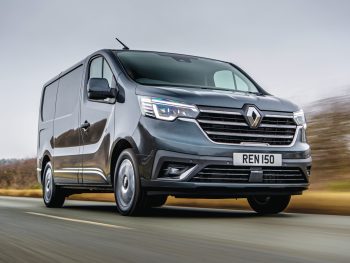A comprehensive redesign for a familar face in the fleet market, says John Kendall.

Renault Trafic LL30 Blue dCi 150 Business Panel Van
Would Renault have imagined that it would manage to get 22 years of life out of a modern van design? Probably not. A new van could be making its appearance later this year, one that will also have an electric power option but, for now, the company has introduced quite a comprehensive re-design to freshen up a familiar face.
The latest Trafic gains from a redesigned front end, including new front bumper, bonnet, grille and standard LED headlamps. Inside there’s a new dashboard and gear lever and there’s more storage space in the cab with up to 84 litres. As before there are two lengths, two roof heights, as well as panel vans and crew vans with seating for up to six.
Engines are based on the same 1,997cc four-cylinder turbodiesel but with a range of revisions. All are fitted with stop and start systems and there is a new variant of the engine, the least powerful 110hp version badged dCi 110 which generates 300Nm of torque at 1,500rpm. This engine is only available in Business trim and with a six-speed manual gearbox. The dCi 130 provides 10hp more than its previous equivalent with 130hp and 330Nm of torque at 1,500rpm. This engine is available with Business, Business+ and Sport trim. The engine is also only available with a six-speed manual transmission. Both the dCi 150 and range-topping dCi 170 are available with either the six-speed manual or six-speed dual-clutch automated transmission (EDC), with the dCi 170 engine reserved for Sport and Sport+ models.
Business+ models upwards feature Renault’s eight-inch EASY LINK display screen, offering Android Auto and Apple CarPlay connectivity, as well as DAB, Bluetooth and USB. Sport and Sport+ models also get satellite navigation.
Our Blue dCi 150 LL30 manual model features the longer wheelbase option with standard height roof. It came with a long list of options from wireless smartphone charger to metallic paint.
We recorded 38.9mpg on test, a good figure compared with the 39.8mpg official combined. As always with our tests, the figure was obtained by keeping to LCV speed limits. The 150hp engine would be plenty powerful enough when fully laden.
Nothing that Renault has done to the interior over the years can really match the ingenuity of the original dashboard design, but the latest version does a good job. It is very much in keeping with the latest Renault car models, using similar switchgear, instrumentation and controls. It looks neat and functional – just the job for a van. The additional storage spaces are welcome, such as the deep dash top bin with two USB charge points. The wireless charging pad was well though out too, angled forward to stop the phone from sliding out. The door mirrors are now larger, providing a better rearward view than before.
Round the back, the load area hasn’t changed over the years, offering a large practical space with plenty of load lashing points. Our van had a single near-side sliding door and had been fitted with ply lining to protect the panels. The low floor height is an attraction if you are loading manually and a single catch means the doors can easily be opened to 180 degrees. Renault had fitted the van with additional slam locks to provide better security.
IN BRIEF
WHAT IS IT? 4×4 Pickup
HOW MUCH? £28,400 (ex-VAT)
LOAD VOLUME? 7.8m3
PAYLOAD? 1,116kg
ECONOMY? 39.8mpg (WLTP combined)
DRIVE? 150hp @ 3,500rpm / 350Nm @ 1,500rpm, 2.0-litre turbo-diesel
VERDICT:
The Trafic may be getting on a bit, but the refreshed design, new engines and up-to-date equipment disguises it well, which shows what a good design the van was when it first came to market.

